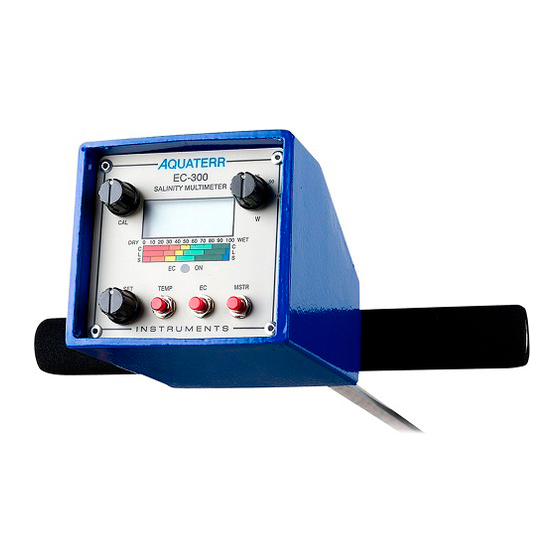
Summary of Contents for AQUATERR INSTRUMENTS M-300
- Page 1 A QUATERR I N S T R U M E N T S M, T & EC -300 User’s Manual Aquaterr Digital Soil Moisture, Temperature and Salinity Meters...
- Page 2 A QUATERR INSTRUMENTS Leader in Portable Soil Measuring Technology...
-
Page 3: Safety Precautions
Do not leave the probe in the soil. If the probe is left in the ground, it can loose intimate contact with the soil resulting in incorrect reading. Guidebook The Aquaterr Instruments Guidebook explains how to use your meter to optimize your irrigation practices by helping you to look at the relationship between plants, soil and moisture. - Page 4 AQUATERR INSTRUMENTS Moisture and Multimeter Owner’s Manual Your patented Aquaterr Instruments Meter can assist you in effective soil-water management. It is light weight and portable providing instantaneous moisture and salinity readings in rapid succession at multiple sites and depths. It is virtually free from errors ordinarily caused by temperature, pH, dissolved salts and metallic ions.
- Page 5 FOUR CRITICAL STEPS While your Meter is easy to use, four important steps must be performed to ensure repeatable results. 1. CALIBRATE the moisture section in IRRIGATION water. Check its calibration every several hours. 2. WIPE THE PROBE with a towel between EACH test, remove all excess dirt. Dirt carryover will cause errors in future readings.
- Page 6 COMMON PROBLEMS (Soil Moisture Measurements) PROBLEMS Insert probe, press the dirt around the Widely varying readings, due to lack of Soil probe by standing close to both sides of the Compaction caused by wiggling the probe. probe. Then take reading. Lower/higher than expected readings.
- Page 7 2. With the moisture calibration knob “W” (upper right side of meter) in the full clockwise position, push the EC button. After about 4 seconds, the “EC-ON” light will illuminate and the meter will read the salinity in µS (microSiemens). 3 WIPE OFF the sensor between readings.
- Page 8 EVALUATING THE MOISTURE MEASUREMENTS It is important to remember that your Meter is a capacitance moisture meter. Capacitance meters “look” at the air-water ratio in the soil. Thus, soil compaction has an affect on the reading. A more compact soil will hold less air than a loose soil (like a sponge). This means that the more compact soil will have higher readings than a loose soil.
- Page 9 COMMOM PROBLEMS (Soil Salinity Measurements) PROBLEMS SOLUTIONS Battery indicator is on Replace the battery quickly. Remove the battery cover and replace with a 9 volt battery. EC of soil matches EC of the water Give more time for the soil to come to equilibrium.
- Page 10 CALIBRATING THE SALINITY FUNCTION (Salinity Multimeter) Caution: This should only be done as a last resort after you have tried everything else and you are certain that it is required. We have provided two methods of calibrating the salinity function. The first method is more convenient for laboratory or controlled conditions;...
- Page 11 SPECIFICATIONS PROBE LENGTH: 30 Inches (76.2cm) PROBE DIAMETER: ! Inch (1.27cm) PROBE CONSTRUCTION: Stainless Steel OVERALL LENGTH: 36 Inches (approx.) (91.44cm) TEMPERATURE RANGE: 4.44 to 65.55 deg. C METER ACCURACY: 1% of full scale POWER SOURCE: 9 volt battery LIFE OF POWER SOURCE: Approx. 3 months WEIGHT: Approx.

Need help?
Do you have a question about the M-300 and is the answer not in the manual?
Questions and answers